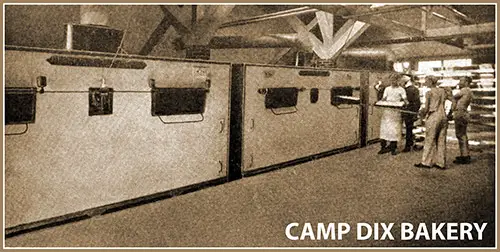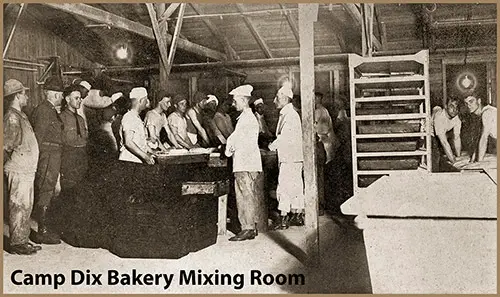The Camp Dix Bakery

The Three Giant Ovens That Bake the Bread for Camp Dix. The Camp Dix News, 13 October 1917, p. 10. GGA Image ID # 1ce34e39a6
The accompanying picture, on this page are shown the three large bread baking ovens in the Camp Dix Bakery, situated in one of the buildings occupied by the School for Cooks and Bakers a little to the south of the high steel water tank. During the past week an average of 16,000 pounds of bread has been baked here daily, about 8,000 loaves, which amount is necessary to feed the army boys in Camp.
A force of 68 bakers under the direct super- vision of Lieutenant George H. Sun- derman, Commanding Officer of the Bakery, and Sergeant James S. Boy- att, Sr. Gr. Q. M. C., Chief Instructor in Baking, are working in three shifts of eight hours each turning the flour into dough and the dough into these big ovens from which comes a constant supply of fresh bread.
A Day No. 3 mixing machine has now been installed, thus eliminating a great deal of the hard work. The total capacity of these ovens is about 36,000 pounds of bread daily and the boys need, therefore, not worry about a plentiful supply at all times of fresh bread, "home-made" at Camp Dix.
Here again is an instance of army economy over the wasteful methods of bread distribution in our large cities. At Camp Dix the Quartermaster's truck delivers bread from this one central bakery to every army kitchen in this city of soldiers. In our large cities where bread is delivered before breakfast a half dozen teams of different bakers may often be serving families in one block.
US Army "Iron-Clad" Bread

Real "Doughboys" in the Bakery Mixing Room. In a Day, as Many as 47,000 Pounds of Bread Have Been Baked at the Camp Dix Bakery. Camp Dix Pictorial Review, 20 July 1918, p. 2. GGA Image ID # 1ce91dcd19
This bread is baked in six-loaf pans, two pounds to the loaf. In the bakery proper, there are three large ovens with a capacity of 660 pounds at one issue. In addition to these, there are two batteries for three field ovens, the six ovens having a combined capacity of more than a thousand pounds.
Every morning big covered motor trucks deliver the bread to the kitchens throughout the Camp, and the boys do the rest.
The "iron-clad" bread of the army is by no means as distasteful as the name might imply. On the contrary, it is delicious and contains a significant amount of nutrition. Bread is the chief article of the soldier's diet, and there is always a bountiful supply of it at the mess.
The crust is purposely made very hard so that it will be impenetrable to dirt and dust and keep the contents moist and fresh. It is crisp and very "tasty"; the loaf's interior is always in excellent condition.
So that the soldier may never lack bread, a bakery company, an adjunct to the quartermaster corps, is attached to each large unit, whether in the camp or the field.
The bakers are skilled men, either those who have had long army experience or those who have graduated from the Cooks and Bakers School, an organization that assures an adequate number of trained cooks and bakers.
The ordinary camp bakery, such as that of Camp Dix, can supply bread for sixty thousand men. One pound a day is the usual ration; the bread is made in two-pound loaves.
The building is a model of cleanliness and efficiency. As about twenty thousand loaves per day are necessary for the complete Camp Dix quota, everything is done on a large scale.
The dough is mixed by electrical machines, thus saving much time and labor, and is baked in huge ranges kept at a standard temperature.
One can gain some idea of the batches' size by the following figures: for each lot are necessary thirty-one gallons of water, fifteen pounds of yeast, ten pounds each of sugar and salt, and four hundred and thirty-seven pounds of white Hour. The daily output of loaves, if placed end to end, would extend for five miles.
So bread is issued to the soldiers until it has stood in the store-room for twenty-four hours. Each morning the supply wagons come to the bakery, load the bread, and distribute it in the amounts desired at the companies' kitchens.
This picture shows one of the cooks outside the camp bakery. He has been baking a small lot of bread for the officers on a field range, such as when troops are in the field.
IN AN accompanying picture, on this page are shown the three large bread baking ovens in the Camp Dix Bakery, situated in one of the buildings occupied by the School for Cooks and Bakers a little to the south of the high steel water tank. During the past week an average of 16,000 pounds of bread has been baked here daily, about 8,000 loaves, which amount is necessary to feed the army boys in Camp.
A force of 68 bakers under the direct super vision of Lieutenant George H. Sunderman, Commanding Officer of the Bakery, and Sergeant James S. Boyatt, Sr. Gr. Q. M. C., Chief Instructor in Baking, are working in three shifts of eight hours each turning the flour into dough and the dough into these big ovens from which comes a constant supply of fresh bread.
A Day No. 3 mixing machine has now been installed, thus eliminating a great deal of the hard work. The total capacity of these ovens is about 36,000 pounds of bread daily and the boys need, therefore, not worry about a plentiful supply at all times of fresh bread, " home-made" at Camp Dix.
Here again is an instance of army economy over the wasteful methods of bread distribution in our large cities. At Camp Dix the Quartermaster's truck delivers bread from this one central bakery to every army kitchen in this city of soldiers. In our large cities where bread is delivered before breakfast a half dozen teams of different bakers may often be seen serving families in one block.
